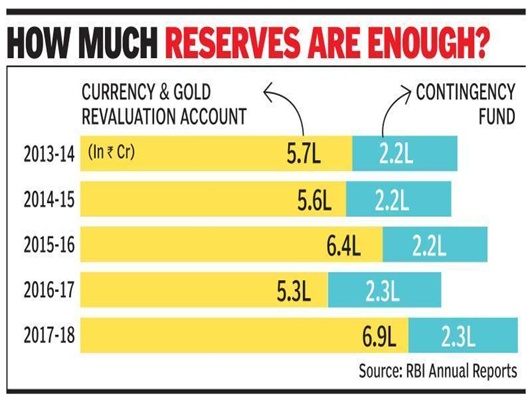In News: The Reserve Bank of India (RBI) recently announced that its board had approved the transfer of a surplus of Rs 30,307 crore to the Union government for the fiscal year 2021-22, while maintaining the Contingency Risk Buffer at 5.5%.
What’s in today’s article:
- What is the RBI surplus? (About RBI surplus and the contingency fund, understanding the above concepts)
- News Summary
What is the RBI surplus?
- About RBI surplus and the contingency fund:
- The RBI’S surplus is the excess of income over expenditure in accordance with the Section 47 of (Allocation of Surplus Profits) of the RBI Act, 1934.
- The RBI earns an income from interest on holding of securities, the net interest it earns from its liquidity operations, interest from deposits held with foreign banks, etc.
- The central bank deducts its expenditure - mainly for printing currency notes and maintaining its operations, to generate a surplus.
- This surplus is generally transferred to the government as a dividend.
- Section 48 (Exemption of Bank from income-tax and super-tax) of the RBI Act, 1934, says that the Bank shall not be liable to pay income-tax or super-tax on any of its income, profits or gains.
- In some years, RBI also sets aside money for a so-called contingency fund (CF) for meeting unexpected and unforeseen contingencies such as a rapid depreciation in the value of securities the RBI holds, risks from an unexpected event like demonetisation, etc.
- The CF has the effect of decreasing its surplus and thus the dividend transferred to the government, leading the Centre to demand more from the central bank.
- The contingency fund, along with other RBI reserves (asset development fund, currency and gold revaluation reserve) form an important part of the RBI balance sheet.
- They add to the RBI’s arsenal to meet unexpected disruptions and provide comfort and confidence to global investors.
- Understanding the above concepts:
-

- In 2017-18, the size of RBI’s balance sheet was Rs 36.2 lakh crore.
- The currency notes RBI prints make up more than half its liabilities and its reserves (26%) forms another big component.
- Gold along with its forex assets make up almost 77% of its assets.
- Reserves with the RBI are two types.
- The Currency & Gold Revaluation Account (CGRA) makes up the biggest share (Rs 6.9 lakh crore in 2017-18). This represents the value of the gold and foreign currency that the RBI holds on behalf of India.
- Simply put, variations in this represent the changing market value of these assets.
- As a result, the RBI gains or losses on this count based on market movements.
- The CF is a specific provision meant for meeting unexpected contingencies that arise from RBI’s monetary policy and exchange rate operations. In 2017-18, it was Rs 2.32 lakh crore.
- In both cases, the RBI intervenes in the relevant markets to adjust liquidity or prevent large fluctuations in currency value.
- The CGRA and CF together accounted for 26% of assets (and because in a balance sheet assets and liabilities must by definition match, also the same proportion of its liabilities).
News Summary:
- The RBI approved a dividend payment of ₹30,307 crore to the Centre for the fiscal year ended March 2022, sharply lower than the government’s expectations.
- The bank’s central board of directors also decided to maintain the contingency risk buffer (CRB) at 5.50%.
- CRB, which comes from the contingency fund, is risk provisioning made from economic capital to cover monetary, credit, fiscal stability and operational risks.
- In the 2022 budget, the government had estimated that it would receive ₹73,948 crore as dividend from the RBI and state-run lenders for FY22, which would be transferred this fiscal.
- The budgeted dividend is 27% less than the ₹1.01 trillion received by the Centre in FY22. The RBI had contributed a whopping ₹99,122 crore.
- Assuming that the government would receive an additional ₹10,000 crore as dividend from state-run banks, this would still fall short of the budgeted amount by about ₹30,000 crore.
- One of the reasons for the lower dividend this fiscal could be that the RBI paid a higher interest on its variable reverse repo auctions last year.
- The central bank had conducted variable rate reverse repo (VRRRs) auction to suck out excess liquidity that it had infused into the banking system following the onset of the pandemic in March 2020.
- While RBI paid a fixed interest of 3.35% on the reverse repo window, it paid a higher interest of 3.55-3.9% on VRRR auctions.
- The spillover from the Life Insurance Corporation of India's initial public offering would absorb a large portion of the RBI's lower-than-expected surplus transfer to the central government.










